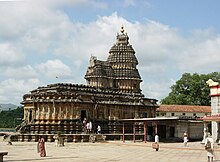
| Part of a series on |
| Hinduism |
|---|
 |
A matha (/mʌt/; Sanskrit: मठ, maṭha), also written as math, muth, mutth, mutt, or mut, is a Sanskrit word that means 'institute or college', and it also refers to a monastery in Hinduism.[1][2] An alternative term for such a monastery is adheenam.[3] The earliest epigraphical evidence for mathas related to Hindu-temples comes from the 7th to 10th century CE.[4]
The most famous Advaita Vedanta mathas or peethams, which came to be affiliated with the Advaita tradition in the 14th century, are Govardhanmaṭha Pīṭhaṃ at Puri, Odisha; Śārada Pīṭhaṃ at Sringeri, Karnataka; Kalika Pīṭhaṃ at Dvāraka, Gujarat; Jyotirmaṭha Pīṭhaṃ at Badari, Uttarakhand; and Sri Kanchi Kamakoti Peetham at Kanchi, Tamil Nadu.
The most famous and influential Dvaita Vedanta mathas or peethams are Ashta Mathas at Udupi, Karnataka; Uttaradi Matha at Bangalore, Karnataka; Vyasaraja Matha at Sosale, Karnataka; and Raghavendra Matha at Mantralayam, Andhra Pradesh.[5][6]
Famous mathas or peethams professing the Vishishtadvaita philosophy include Parakala Matha at Mysore, Karnataka; Ahobila Matha at Ahobilam, Andhra Pradesh; and Srimad Andavan Ashramam at Srirangam, Tamil Nadu.
Other major and influential mathas belong to various schools of Hindu philosophy, such as those of Vaishnavism and Shaivism.[7][8] The monastery host and feed students, sannyasis (monks, renouncers, ascetics), gurus and are led by acharyas. These monasteries are sometimes attached to Hindu temples and have their codes of conduct, initiation and election ceremonies.[9][10] The mathas in the Hindu tradition have not been limited to religious studies, and historical evidence suggests that they were centers for diverse studies such as medieval medicine, grammar and music.[11]
The term matha is also used for 'monastery' in Jainism, and the earliest monasteries near Jain temples are dated to be from about the 5th-century CE.[12]
- ^ Tamara I. Sears (2014). Worldly Gurus and Spiritual Kings: Architecture and Asceticism in Medieval India. Yale University Press. pp. 4–9. ISBN 978-0-300-19844-7.
- ^ Matha, Encyclopædia Britannica Online 2009
- ^ Also transliterated ādīnam, adinam, aadheenam, aadheenm, etc.
- ^ Scharfe 2002, p. 172-173.
- ^ The Illustrated Weekly of India. Bennett, Coleman & Company, Limited, at the Times of India Press. 1972. p. 21.
Apart from the eight maths, three important maths outside Udipi have played a significant part in upholding and spreading the message of Dvaita: the Uttaradi Math (Bangalore) and the Raghavendraswami Math (Nanjangud) and the Vyasaraya Math (Sosale). Particularly mention must be made of the outstanding contribution of the late Satyadhyanatirtha of the Uttaradi Math - a giant intellectual indeed.
- ^ Steven Rosen (30 November 1994). Vaisnavism. Motilal Banarsidass Publishers. p. 132. ISBN 9788120812352.
- ^ Cite error: The named reference
vraoltcc27was invoked but never defined (see the help page). - ^ Sears, Tamara I. Housing Asceticism: Tracing the development of Mattamayura Saiva monastic architecture in Early Medieval Central India (c. 8th – 12th centuries AD). PhD. Dissertation 2004. p. 29
- ^ Johnston 2013, p. 681–683.
- ^ Cite error: The named reference
vraotcc4was invoked but never defined (see the help page). - ^ Cite error: The named reference
scharfetempleschoolswas invoked but never defined (see the help page). - ^ Paul Dundas (2003). The Jains. Routledge. pp. 123–124. ISBN 978-0415266055.